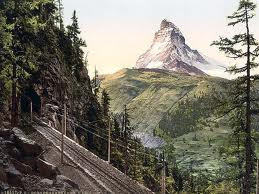The Matterhorn is a mountain in the Pennine Alps on the border between Switzerland and Italy. Its summit is 4,478 metres high, making it one of the highest peaks in the Alps. The four steep faces, rising above the surrounding glaciers, face the four compass points. The mountain overlooks the town of Zermatt in the canton of Valais to north-east and Breuil-Cervinia in the Aosta Valley to the south. The Theodul Pass, located at the eastern base of the peak, is the lowest passage between its north and south side.
The Matterhorn was the last great Alpine peak to be climbed and its first ascent marked the end of the golden age of alpinism. It was made in 1865 by a party led by Edward Whymper and ended tragically when four of its members fell to their deaths on the descent. The north face was not climbed until 1931, and is amongst the six great north faces of the Alps. The Matterhorn is one of the deadliest peaks in the Alps: from 1865 – when it was first climbed – to 1995, 500 alpinists died on it.
The Matterhorn has become an iconic emblem of the Swiss Alps and the Alps in general. Since the end of the 19th century, when railways were built, it attracted more and more visitors and climbers. Each summer a large number of mountaineers try to climb the Matterhorn via the north-east Hörnli ridge, the most popular route to the summit.
The Matterhorn has a pyramidal shape with four faces facing the four compass points: the north and east faces overlook, respectively, the Zmutt valley and Gornergrat ridge in Switzerland, the south face (the only one south of the Swiss-Italian border) fronts the resort town of Breuil-Cervinia, and the west face looks towards the mountain of Dent d'Hérens which straddles the border. The north and south faces meet at the summit to form a short east-west ridge.The Matterhorn's faces are steep, and only small patches of snow and ice cling to them; regular avalanches send the snow down to accumulate on the glaciers at the base of each face, the largest of which is the Zmutt Glacier to the west. The Hörnli ridge of the northeast (the central ridge in the view from Zermatt) is the usual climbing route.
Tourism
Since the eighteenth century the Alps have attracted more and more people and fascinated generations of explorers and climbers. The Matterhorn remained relatively little known until 1865, but the successful ascent followed by the tragic accident of the expedition led by Edward Whymper caused a rush on the mountains surrounding Zermatt.
The construction of the railway linking the village of Zermatt from the town of Visp started in 1888. The first train reached Zermatt on July 18, 1891 and the entire line was electrified in 1930. Since 1930 the village is directly connected to St. Moritz by the Glacier Express panoramic train. However there is no connection with the village of Breuil-Cervinia on the Italian side. Travellers have to hire mountain guides to cross the 3,300 metres high glaciated Theodul Pass, separating the two resorts. The town of Zermatt remains completely free of internal combustion vehicles and can be reached by train only. (Electric vehicles are used locally).
Climbing history
The Matterhorn was one of the last of the main Alpine mountains to be ascended, not because of its technical difficulty, but because of the fear it inspired in early mountaineers. The first serious attempts began around 1857, mostly from the Italian side; but despite appearances, the southern routes are harder, and parties repeatedly found themselves having to turn back. However, on July 14, 1865, English mountaineers in what is considered the last ascent of the golden age of alpinism, the party of Edward Whymper, Charles Hudson, Lord Francis Douglas, Douglas Robert Hadow, Michel Croz and the two Peter Taugwalders (father and son) was able to reach the summit by an ascent of the Hörnli ridge in Switzerland. Upon descent, Hadow, Croz, Hudson and Douglas fell to their deaths on the Matterhorn Glacier, and all but Douglas (whose body was never found) are buried in the Zermatt churchyard.
Only three days after Whymper's ascent, the mountain was ascended from the Italian side via an indirect route by Jean-Antoine Carrel and Jean-Baptiste Bich on July 17, 1865.
History
Aegidius Tschudi, one of the earliest Alpine topographers and historians, was the first to mention the region around the Matterhorn in his work, De Prisca ac Vera Alpina Raethi, published in Basel in 1538. He approached the Matterhorn as a student when in his Alpine travels he reached the summit of the Theodul Pass but he does not seem to have paid any particular attention to the mountain itself.
The Matterhorn remained unstudied for more than two centuries, until Horace Benedict de Saussure (a philosopher and geologist from Geneva who had already studied Mont Blanc) travelled to the mountain, which filled him with admiration. However de Saussure was not moved to climb the mountain, and had no hope of measuring its altitude by taking a barometer to its summit. "Its precipitous sides," he wrote, "which give no hold to the very snows, are such as to afford no means of access." Yet his scientific interest was kindled by "the proud peak which rises to so vast an altitude, like a triangular obelisk, that seems to be carved by a chisel." His mind intuitively grasped the causes which gave the peak its present precipitous form: the Matterhorn was not like a perfected crystal; the centuries had laboured to destroy a great part of an ancient and much larger mountain.












No comments:
Post a Comment